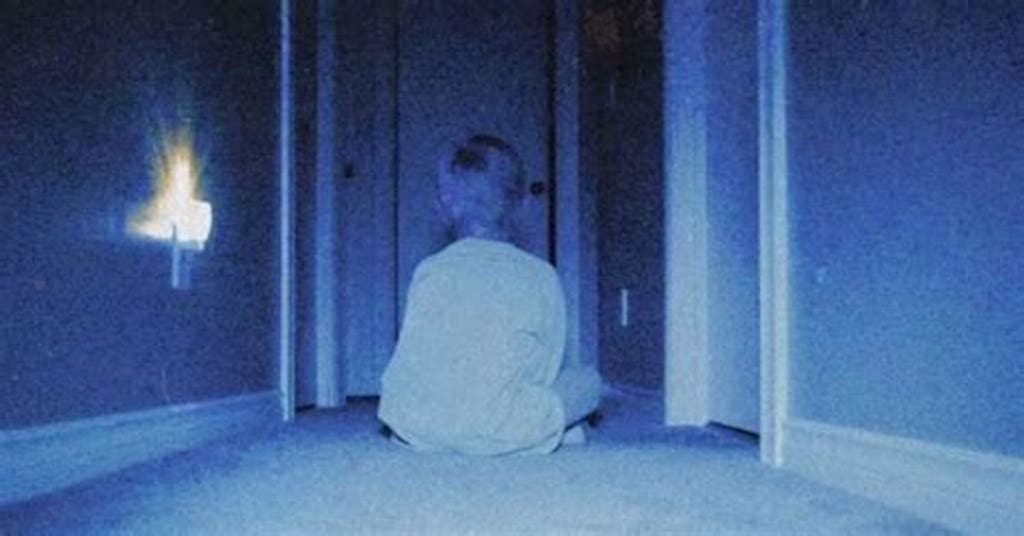Kyle Edward Ball is an experimental horror filmmaker from Edmonton, Alberta. In 2017, he began a YouTube web series called Bitesized Nightmares where he recreates real people’s dreams and nightmares using minimalism and old Hollywood inspired trick photography. That informed his unconventional style of filmmaking.
He wrote and directed his first feature film Skinamarink earlier this year which secured a theatrical release, deep praise for its abstract sensibilities, and a whole lot of head scratching.
Drawing on the visceral fear of the children losing their parents, Skinamarink began its life as a proof of concept short film called Heck which went viral to become a social media sensation. The barely perceptible story centers on two children Kevin (Lucas Paul) and his sister Kaylee (Dali Rose Tetreault) who wake up during the night and find that their father is missing and the windows and doors to their house are gone too.
Skinamarink unravels as an loose, immersive mood piece of atmospheric cinema rather than a traditional horror film narrative. Its aesthetic has been described as more dreadful and terrifying rather than scary. It’s been compared to avant guard filmmakers like David Lynch, Jane Schoenbrun, and Robert Bresson who often tell their stories as perplexing dreams straddling nightmares. The film is a murky, grainy roll of celluloid, and shot in odd angles which adds to its intention.
It most closely resembles a found footage film where the audience needs to watch hours of footage and piece a story together. There are shadows, hidden faces, and muted dialogue. It’s as disorienting as it is engaging since much of the lighting is a flickering late night television screen. It leaves a similar pit in your stomach you experience when you come home late at night and not sure if there’s an intruder in your house, but sense something is off.
Skinamarink demands its audience do the heavy lifting in terms of a discernible through line and theme. But Kyle Edward Ball gives us the basic tools to get started and interpret his opus as we see fit. Creative Screenwriting Magazine caught up with Kyle Edward Beall to discuss the inspiration behind his work.
Discuss the impetus and influences in making Skinamarink?
I think every horror filmmaker wants to do their version of “the big scary house movie” at some point. I wanted to do my version and make it as personal and as quiet as possible. I also wanted to do it as a lo-fi “old” movie. Like something you would discover late at night.
How do you maintain a feature length narrative based on mood and so little dialogue?
It really all came down to planning. I spent forever thinking over the structure and story in my head before I typed a single word. Then when I got down to writing it, I tried my best to move the story along while still trying to maintain the atmospheric style and trying to be as sparse as possible with the dialogue. Then, over pre-production, I found I could trim the dialogue even more, and then in editing even more.

Kyle Edward Ball
What audience are you attracting given its eclectic storytelling style?
I’ve had a wide range of fans of all shapes, sizes and ages. With that being said, Gen-Z seems to really like my work. It’s been incredible. I did an impromptu meet and greet at a screening in Columbus, and there was a line-up of mostly college kids to meet me. It made me feel so humbled.
Discuss your YouTube channel and your short Heck which became the basis for Skinamarink?
A few years after film school I started a YouTube channel where people would comment on nightmares they’ve had and I would re-create them. While making these videos, I kind of learned who I was as a filmmaker. What I was good at, not good at, and how I wanted to tell a story. After doing this for a few years I decided it was time to make a feature. I didn’t feel I was 100% ready so I did a proof of concept short film called Heck. I was happy with how Heck turned out and went to work on Skinamarink. I like to think Heck kind of stands on its own, separate from Skinamarink. The ideas and themes are different, but overlap in a few ways.
How else did you create buzz for your project?
Before the Shudder announcement, I had a lot of fun with marketing. For example, for each festival we played at, I made a special poster just for the festival. When we had our international premier in Italy, I made a poster that said, “The film that shocked Fantasia, comes to Europe…” Then, after the piracy leak in October 2022 and subsequent Shudder announcement, the buzz was really organic and out of my control. I didn’t really need to do anything outside of taking interviews and responding to fan tweets.
Discuss the crowdfunding campaign and how did it move the project along?
We used the film specific crowdfunding platform Seed & Spark. They’re great. They are very supportive and also teach you how to make your campaign successful. Once we hit our crowdfunding goal, pre-production was off to the races, so to speak. It was also fortunate that all the producers were my friends and excited to see me make my first film.
Describe your filmmaking process in terms of making an ultra low-budget film?
I think the trick of it was, from day one, even before I started writing the script, I designed the film to be something I could do on very little budget. If you are smart about it and know how much it costs and takes to make a film, it can work swimmingly.
How long was the process from Heck to Festival Circuit to Theatrical Release?
About three to four years.
What did you learn about filmmaking along the way?
Be nice. Every film is made by a community. Plan like you’re climbing everest. Working with child actors is easier than you think, provided you make the set and working hours as kid friendly as possible.
